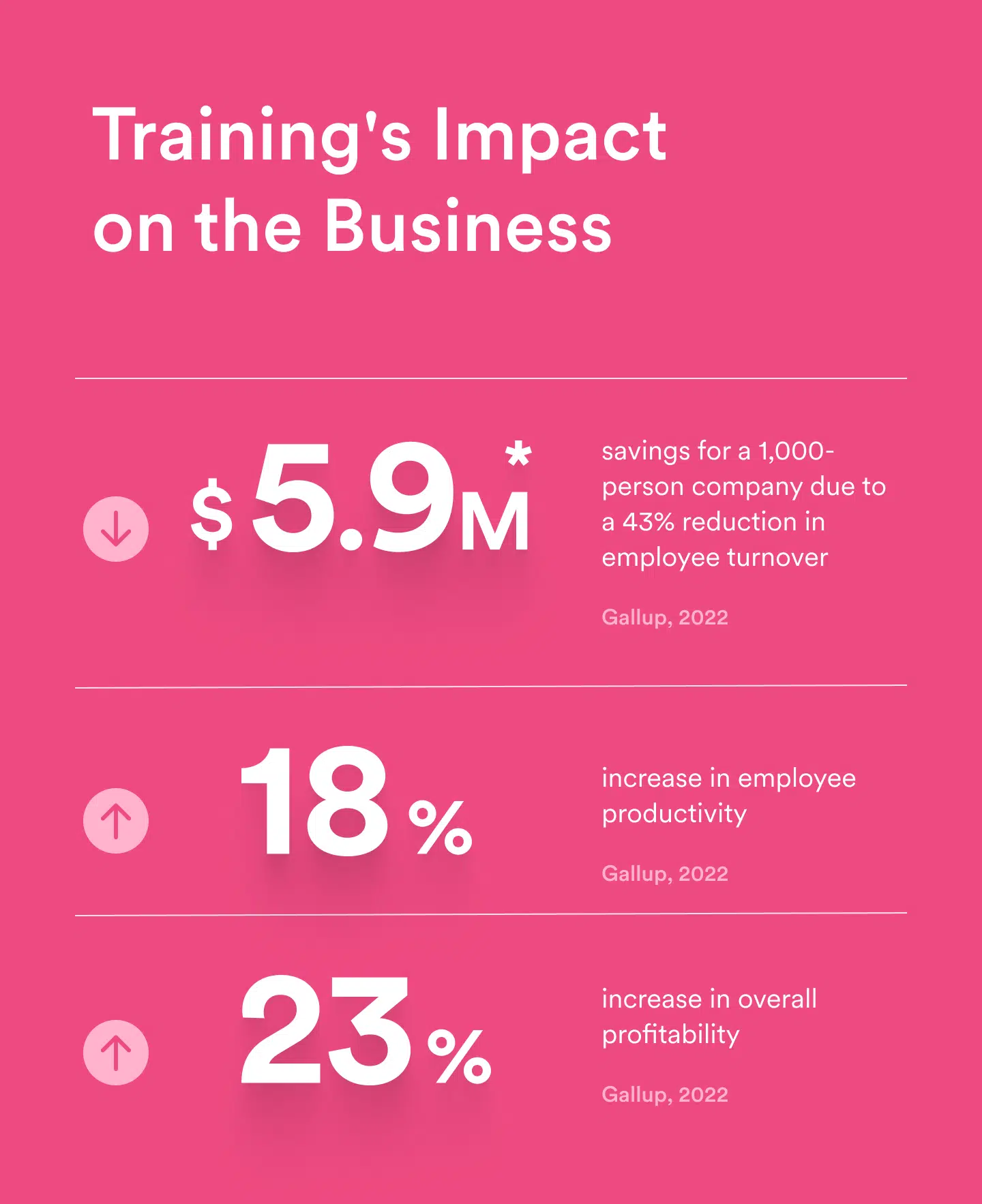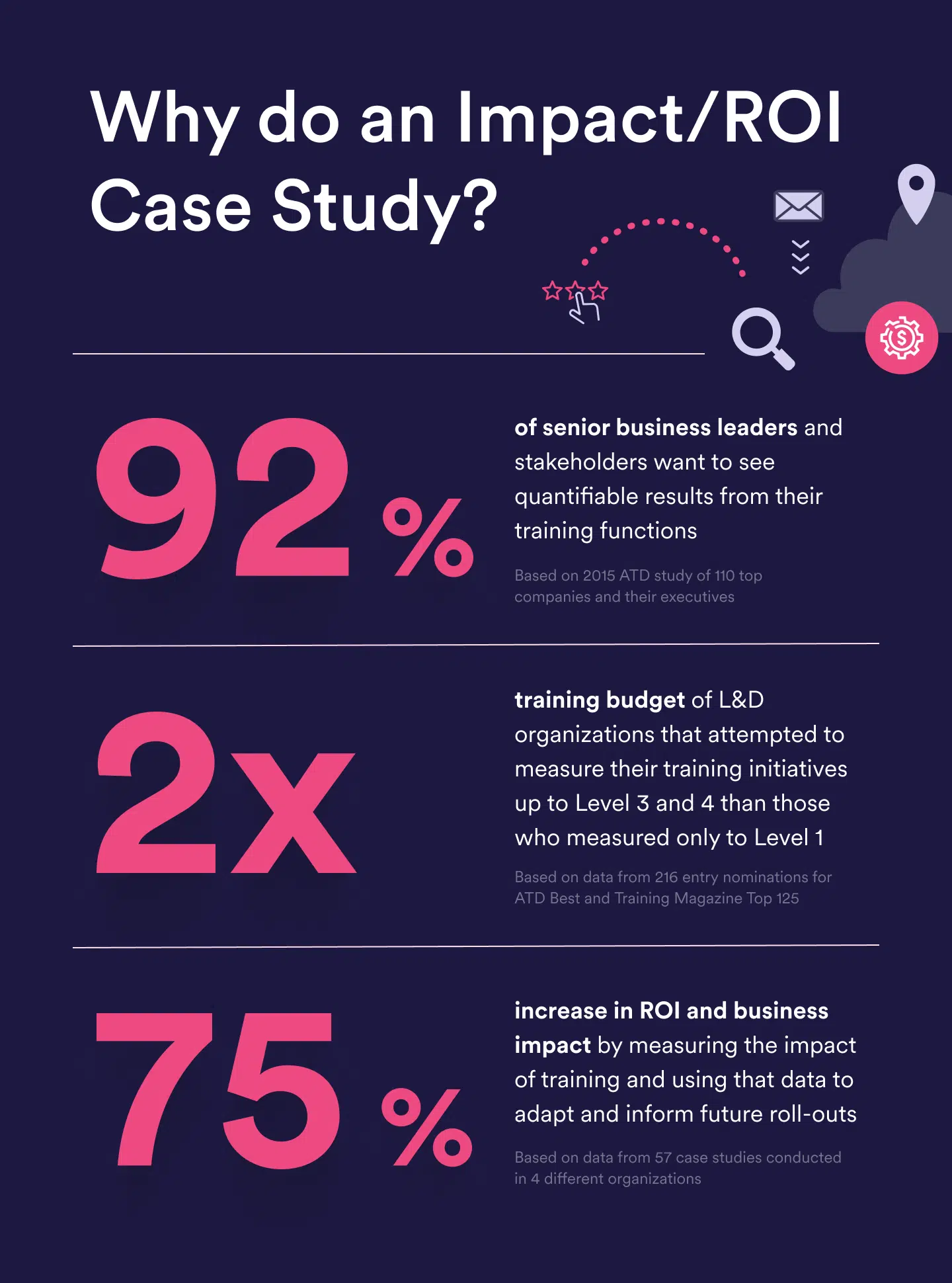Business leaders need to see a measurable benefit for every potential business expense. How else can they determine whether it’s worth the investment? Employee training is no exception to that rule, but connecting the program’s cost to its impact can feel daunting. Unlike capital investments or business operations, calculating the payoff for employee training gets a little fuzzier. But it is possible, particularly when factoring in the cost of not training.
Thus, the total return on investment combines the benefits the company receives from training and what the business avoids by offering it. The sum of those parts actually creates a meaningful ROI in most cases. But it requires a bit of nuance and foundation laying.
Why is Investing in Training and Development Important for Your Organization?
Employee training, when done well, should create a win-win scenario for the entire organization. Individual employees learn new skills and build on existing ones, making them more productive. As a result, their job satisfaction increases while they feel like they’re also preparing for their next one. Meanwhile, the company gets a more efficient, skilled, and dedicated workforce. This can boost morale and output, eventually leading to bottom-line gains.
Providing opportunities for professional development shows employees that the business cares about their growth and future. This is particularly relevant when those training programs extend beyond company- or product-specific learning to include soft skills that aid management, collaboration, and communication.
Companies also see massive upgrades in other key areas beyond boosting employee morale and performance. According to a new study by the Josh Bersin Company, organizations providing cohort-based leadership development are 1.9 times more likely to innovate effectively. They’re also 1.6 times more likely to unleash their employee’s full potential. That leads to increased sales, better customer service, optimized logistics, and—ideally—higher profits.
What is the True Cost of NOT Training Employees?
Some internal stakeholders may balk at the dollars and person-hours dedicated to training. But, they rarely consider the downsides of the alternative. Neglecting employee training often leads to undesirable outcomes.
At the organizational level, businesses typically see significant dividends from high-quality employee training programs. According to Gallup, turnover drops on average by 43%, representing $5.9 million in savings for a typical 1,000-person company. In addition, employee productivity jumps by 18% and profits by 23% for these firms.
Meanwhile, for individual employees, these training programs represent an investment in them. Without ongoing training, many workers may assume the business doesn’t care about their individual professional growth. That quickly leads to apathy, disengagement, and employee turnover. If you’re not willing to invest in me, why should I go above and beyond for you?
Beyond individual employee satisfaction at the macro level, neglecting employee training means workers continue using inferior communication, collaboration, and leadership methods. Lacking training on the better ways to do things, they’ll keep doing them the only way they know how.
This hurts overall efficiency and creates inconsistent approaches from person to person and team to team. This might ultimately create significant disconnects, delays, and conflicts.
Presenting the Full ROI of Investing in Employee Training
Whenever a company considers diverting funds to a given initiative, the powers that be want to know they’re getting their money’s worth. Not only is training an expense, but it also represents an opportunity cost as those funds and time won’t get spent on something else.
That’s why it’s critical to focus on the long-term impact of training. You’re competing for management’s attention and budget against other investment opportunities. They often already have a clearer ROI and historical precedent. The company knows how many more deals they can expect when they hire a new salesperson or spend another $10,000 on marketing. You must lay out the business case with similar clarity. Reposition training from a nice-to-have to a must-have proposition.
Senior leadership wants to see quantifiable results from any training. But internal learning and development organizations rarely provide those specifics. Moreover, doing training right likely demands a much more extensive training budget than the organization currently has. Thus it’s essential to build a solid case for that investment by providing those details.
This requires quantifying the impact of employee training (and the true cost of not training). But where can you come up with those numbers before the program is funded and rolled out? Luckily, your company isn’t the first firm to invest in high-quality employee training programs. So use their experiences to inform your own.
Use Training Case Studies to Support Benchmarks
Leveraging case studies provides a benchmark for your company’s expected impacts. For example, if it helped a similarly-sized company in a comparable industry reduce employee turnover by 10%, apply that to your business’s numbers. You already know how much money and time it takes to recruit, hire, and onboard a new employee. Do the math and show the potential impact on your own company.
Calculating the ROI itself isn’t difficult. To get the ROI percentage, divide the benefits minus the costs by the costs and then multiply it by 100 (i.e. [(benefits-cost)/cost] x 100). So, for example, if training costs $100K and the expected benefit is $300K, it’s a 200% ROI. But even at a 1% ROI, employee training pays for itself and then some.
When your own employee training program begins ramping up, use surveys and other assessments to measure participation rates, satisfaction, skill acquisition and mastery, and actual performance improvements. These results inform the overall ROI calculation, but it’s only looking at things in the short term. Over a more extended period, productivity gains, turnover reduction, and other benefits start adding up.
Making the Build vs. Buy Decision for Employee Training
Many organizations already develop and deliver some or all of their employee training themselves. While this makes sense for company-specific training, when it comes to leadership, communication, and “soft skills” curricula, there are rarely any savings going the DIY route.
Companies outsourcing the development and delivery of employee training get to leverage best-in-class materials and a curriculum based on the latest, cutting-edge research in the field. Unfortunately, in-house staff doesn’t have the same resources to cobble together a compelling training curriculum. Nor do they have the time and expertise to research and license those top-flight materials.
Experienced trainers also provide superior class experiences. They bring many experiences with many other companies to the table. They do this all the time, so they’re up to date on the ideal ways to engage students. They’re trained to create lively discussions and facilitate the practical application of the skills they teach during group exercises.
Freeing staff from curriculum development and delivery means they can focus on other tasks. This includes company-specific matters and soliciting feedback from employees and managers about different training needs. With less on your collective plates, you can give other issues the attention they deserve.
Learning and Development Staff Deserve to Learn, Too!
After spending so much time crafting an ideal training program for your diverse workforce’s needs and desires, there’s often little time left for you and your team. But opting for cohort-based live virtual training ensures the learning and development team won’t get left out of the fun.
There’s training specifically for human resources, people management, and learning and development. Create the same career growth and development opportunities for the team members that worked hard to deliver training to the rest of the workforce.
















